Choosing Perfect Halloween Costumes for Adults on the Spectrum
Halloween isn’t just for kids! Many adults love to celebrate the spooky fun as well. One way to get into the “spirit” is by wearing Halloween costumes for adults to embrace the season.
After all, there are parties to attend, fall harvest events, haunted houses to consider, scary movies to watch, and trick-or-treating activities—grown-up style!
The end of October is often a favorite time for all ages, filled with spooky and not-so-scary decorations, tasty treats, creative costumes, and pumpkins galore. For many neurotypical adults, picking out Halloween costumes for adults for an upcoming party is a fun experience.
However, for adults with autism, the selection process for finding Halloween costumes for adults can be stressful and overwhelming.
Costume shops tend to be crowded, loud, and visually stimulating environments. Dressing rooms are often small, underlit, and have tons of previously tried-on and left costumes by customers.
In addition, individuals with autism may have challenges finding something to wear because it’s too uncomfortable or doesn’t meet their tactile requirements due to fabrics that don’t breathe or scratchy materials. Costumes are often made from cheap materials, as they are typically considered one-time use for most, and those fabrics may cause discomfort. They may also struggle with finding something that fits their special interests.
The good news is that with some planning and accommodation, adults with autism can find comfortable, creative costumes that align with their sensory requirements and comfort levels. Even better, simple Halloween costumes or unique costume ideas are in abundance!
Here are some tips to make finding ideal Halloween costumes for adults less daunting so you can have a fun Halloween!
Halloween Costumes for Adults: Focus on Interests and Passions
A great place to start when looking for unique costume ideas is thinking about topics you already enjoy or feel passionate about. Basing a costume around a special interest can make the process more engaging and enjoyable.
For instance, if you love Star Wars, dress up as your favorite Jedi or Sith. If trains are your thing, go as an old-timey train conductor. Pokemon fans could go as their top gym leader.
Feed your existing passions and let them guide your costume selection.
Lean into your obsessions and deepest interests to find a costume idea that excites you. Not only will this make prep more fun, but it will ensure you feel confident and comfortable wearing the costume.
You want to avoid picking a random costume that doesn’t speak to you just for the sake of having one. Let your passions drive the process. Plus, a costume you like can serve as a great conversation starter!
Consider Sensory Issues When Choosing Halloween Costumes for Adults with Autism
Another factor is considering potential sensory issues with various costume options. For example, bulky costumes that limit mobility may not work well. Tight-fitting outfits or wigs and masks that overstimulate the senses are also difficult. Fabrics that are scratchy or irritating are a no-go.
Any costume that decreases comfort and ramps up stress should be avoided.
Instead, look for lightweight, breathable costume materials that don’t pinch, scratch, or irritate. Test out any accessories or props ahead of time to gauge sensory reactions. Modify or omit pieces as needed to reduce sensory discomfort. Remember that simple Halloween costumes are just as much fun.
Autistic adults may also benefit from costumes with pockets to hold essentials like fidget toys or headphones. The goal is minimizing triggers and maximizing fulfillment.
Don’t be afraid to alter a costume to optimize sensory needs.
Shop Strategically When Seeking Halloween Costumes for Adults
It’s ideal to shop for a costume online or during off-peak store hours. Brick-and-mortar costume stores can be loud, crowded, and overwhelm the senses. If possible, browse costume options on your computer where you control the experience. Shopping online allows you to take your time evaluating choices without pressure.
If you must shop in person, aim to go on a weekday or at times when stores are less busy. Avoid peak Halloween season hours. Many popular Halloween retailers open seasonally beginning in September, so shop early for less crowds and a better selection.
Bring noise-cancelling headphones or sunglasses to help manage sensory stimulation. You may also want to take a trusted friend along for support. Call ahead to ask staff when their slowest hours are so you can plan accordingly.
Drawing inspiration online can provide unique costume ideas that align with your interests and comfort levels. Spend time looking through autism blogs and forums for suggestions.
Check social media for pictures of adults in Halloween costumes that speak to you. Connect with other autistic adults online to swap costume ideas and recommendations.
Get Creative with Costume Comfort When Seeking Halloween Costumes for Adults
With some flexibility and customization, you can take almost any costume and make it work for your needs:
- Substitute scratchy materials for soft, breathable ones
- Sew flaps of fabric on the inside of a costume to hide fidget tools or snacks
- Use costume makeup instead of claustrophobia-inducing masks
- Pick open-finger gloves rather than full gloves to avoid sweaty hands
- Use costume glasses frames with the lenses popped out as a comfortable alternative to masks
- Rig up a harness under the costume to attach a weighted lap pad for soothing pressure
- Use foam floor mats to add padding and cushioning to bulky, hard costumes
The options for unique costume ideas are endless when you think outside the box. Don’t be afraid to alter pieces or repurpose items to enhance comfort. Any adjustments that allow you to have fun, even with simple Halloween costumes, are worth it.
Find Supportive Friends When Shopping for Halloween Costumes for Adults

Attending costume parties can already feel challenging for some autistic adults due to the social dynamics. Surrounding yourself with supportive, understanding friends makes a big difference.
Reach out to friends you trust and who help you feel accepted. Let them know that you may need some extra assistance or patience as you pick out and wear your costume.
True friends will be happy to lend an ear and provide positive encouragement.
If you’re concerned about feeling overwhelmed at the party itself, agree on a plan beforehand with friends. They can check in periodically and help redirect you to a quiet area for a break if needed. Or designate a “signal” to discreetly let them know you need support.
Connecting with friends who “get you” and respect your needs means you don’t have to navigate costume shopping or the party alone. Having allies and a support network along the way makes the experience more doable and enjoyable. And, that’s the goal … to enjoy an event filled with pretend and fantasy, to connect with others, and to have a good time!
Practice Wearing the Costume Ahead of Time
Before the big costume party, set aside some time to practice wearing your full costume at home. This gives you a chance to test-run the entire outfit and make any additional tweaks for comfort.
Wear the costume for short periods, building up duration incrementally. Pay attention to areas of sensory discomfort – pinching, scratchiness, heaviness, etc. Make more modifications where needed.
Be sure you can see and hear clearly, and can eat and drink while wearing the costume. Make sure you can also go the bathroom easily (nothing is worse than not being able to zip or re-connect your costume correctly after answering nature’s call).
Also, note what areas of the costume help you feel relaxed. For example, perhaps the fabric has a soothing texture, or wearing a character’s gloves provides nice pressure. Take note so these elements can be incorporated.
Gradually acclimate until you can comfortably wear the costume for the duration of the Halloween party. This rehearsal time lets you smooth out any lingering issues beforehand. Showing up prepared and accustomed to your costume will help you feel more at ease.
On Halloween, Focus on Enjoying Yourself

Use strategies at the party like taking sensory breaks and connecting with your supportive friends. Stimming openly can also help provide comfort and focus. Above all, listen to your needs.
By tapping into your interests for inspiration, optimizing for sensory needs, and utilizing your support system, finding autism-friendly and simple Halloween costumes for adults can be manageable and gratifying.
Approach it step-by-step and the result will be an opportunity for awesome self-expression!
Focus on Enjoying the Party
Most importantly, remember that your costume should help you feel happy and confident at the Halloween party. If an aspect of your outfit is causing distress, ditch it. Autistic adults already stretch themselves in social situations – your costume shouldn’t add unnecessary strain.
With the right modifications and choice of costume, you can have an enjoyable time at the party without extra worries. Use your special interests to inspire a personalized costume that fits your comfort needs.
Shop strategically and get creative with tweaks. With the proper costume that is autism-friendly (whether for an adult or a child), you’ll feel ready to mingle, show off your look, and have fun!
More Halloween-Related Blogs for Individuals with Autism
I’ve written other blogs about Halloween and enjoying the holiday safely and comfortably when you have autism. Check them out:
- Playing Dress Up: How to Make Trick or Treating Fun for Children with Autism
- Scary Haunted Houses: Love of Hate, It’s Okay Either Way
- Are Horror Movies Good Entertainment for Individuals on the Spectrum? It May Depend on What You Choose
You might also be interested in the following articles:
Misconceptions That Lead To Autism Stigmas and Stereotypes
Learn more about stigmas and stereotypes that autistics face:
- Autism and Holidays: Why Special Occasions Can Be Challenging
- Why Labeling People Can Lead to Stereotyping and Discrimination
- Autism Media Stereotypes: We’re Not All Geniuses, Savants, or Lonely
- Beyond Stereotypes: How Rain Man Revolutionized the Perception of Autism
- Absurd Plot About Autism and Evolution and Why It’s Harmful
- Moving Past the Tired Conspiracy Theory of Vaccines and Autism
- Discover the Powerful Bond Between Autism and Pets
- The Hidden Hurdles: Challenging Autism Stigmas in Today’s Politics
- History of Autism: Revealing Shocking Mysteries from the Past
- Knocking Down the Stigma to Autism Obsession
